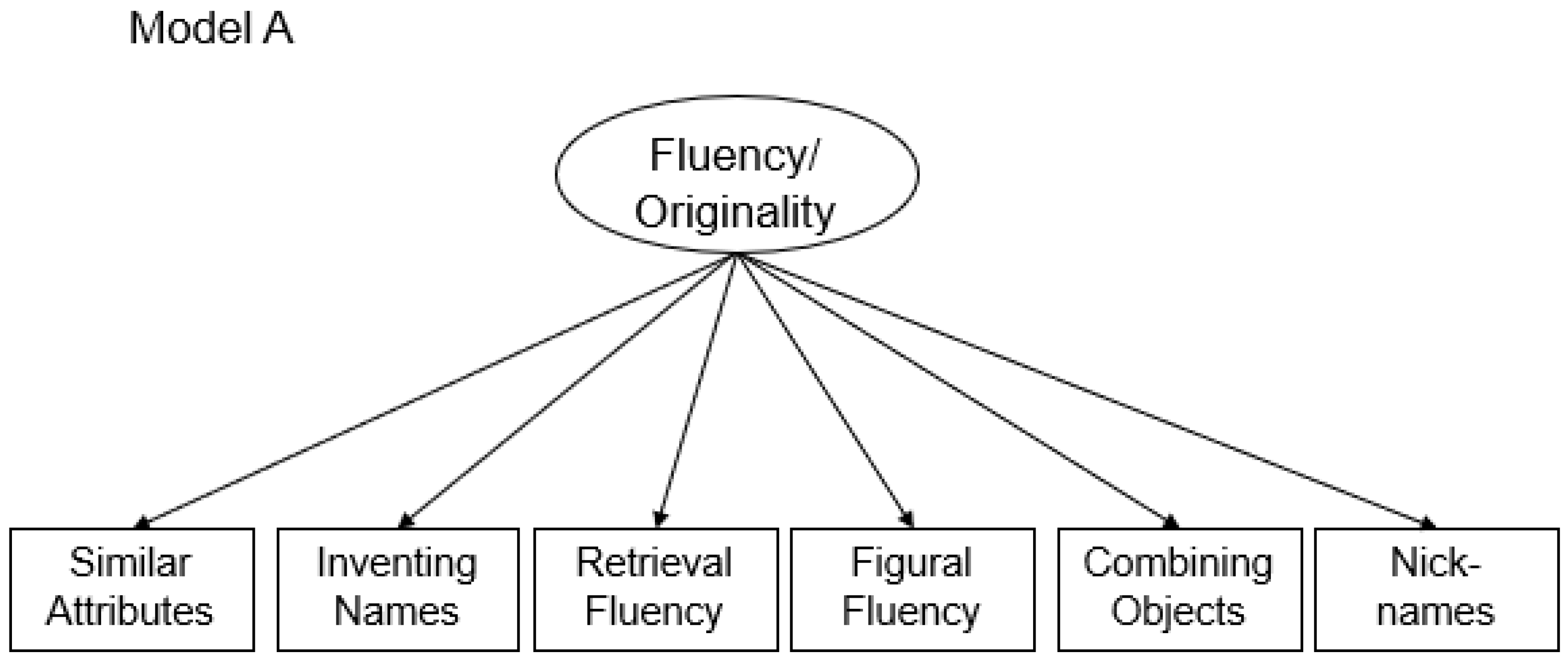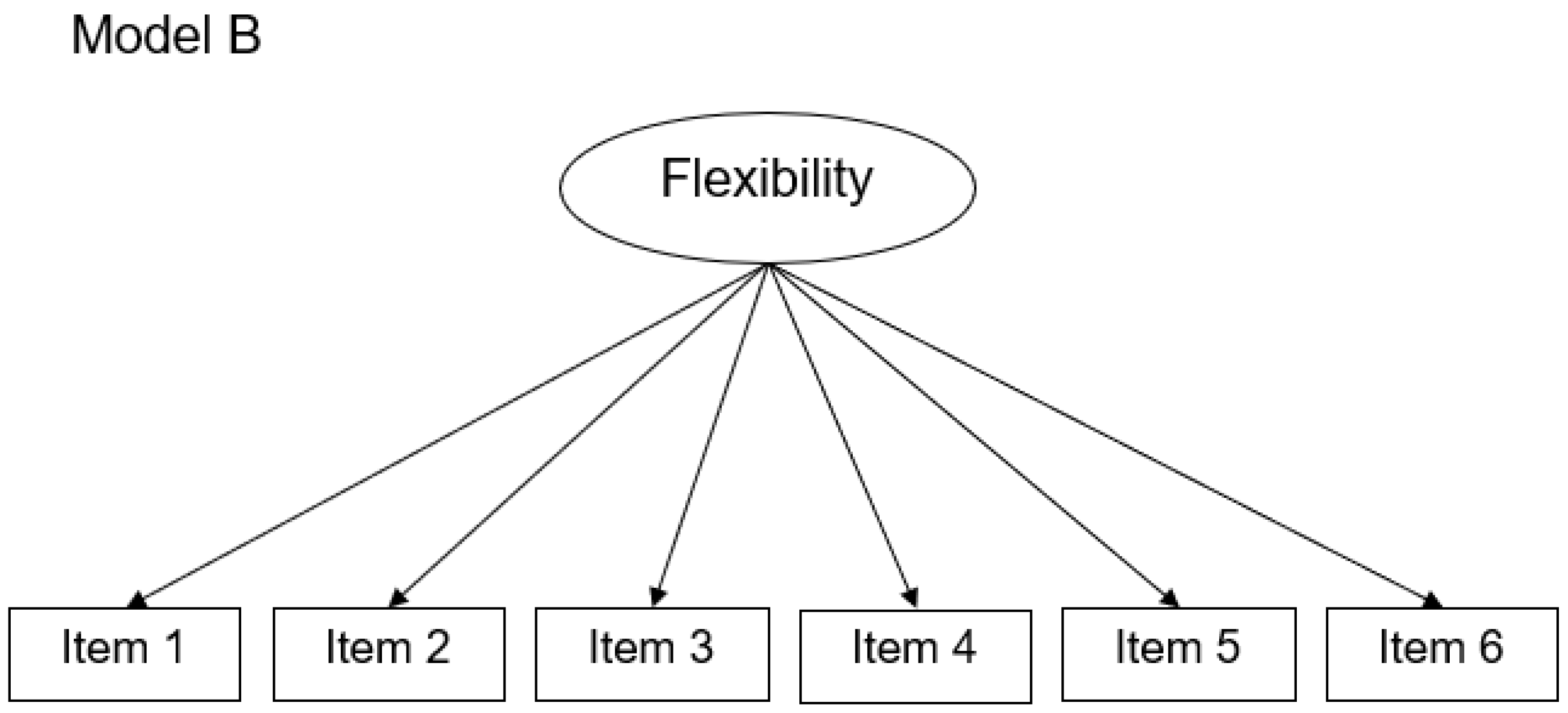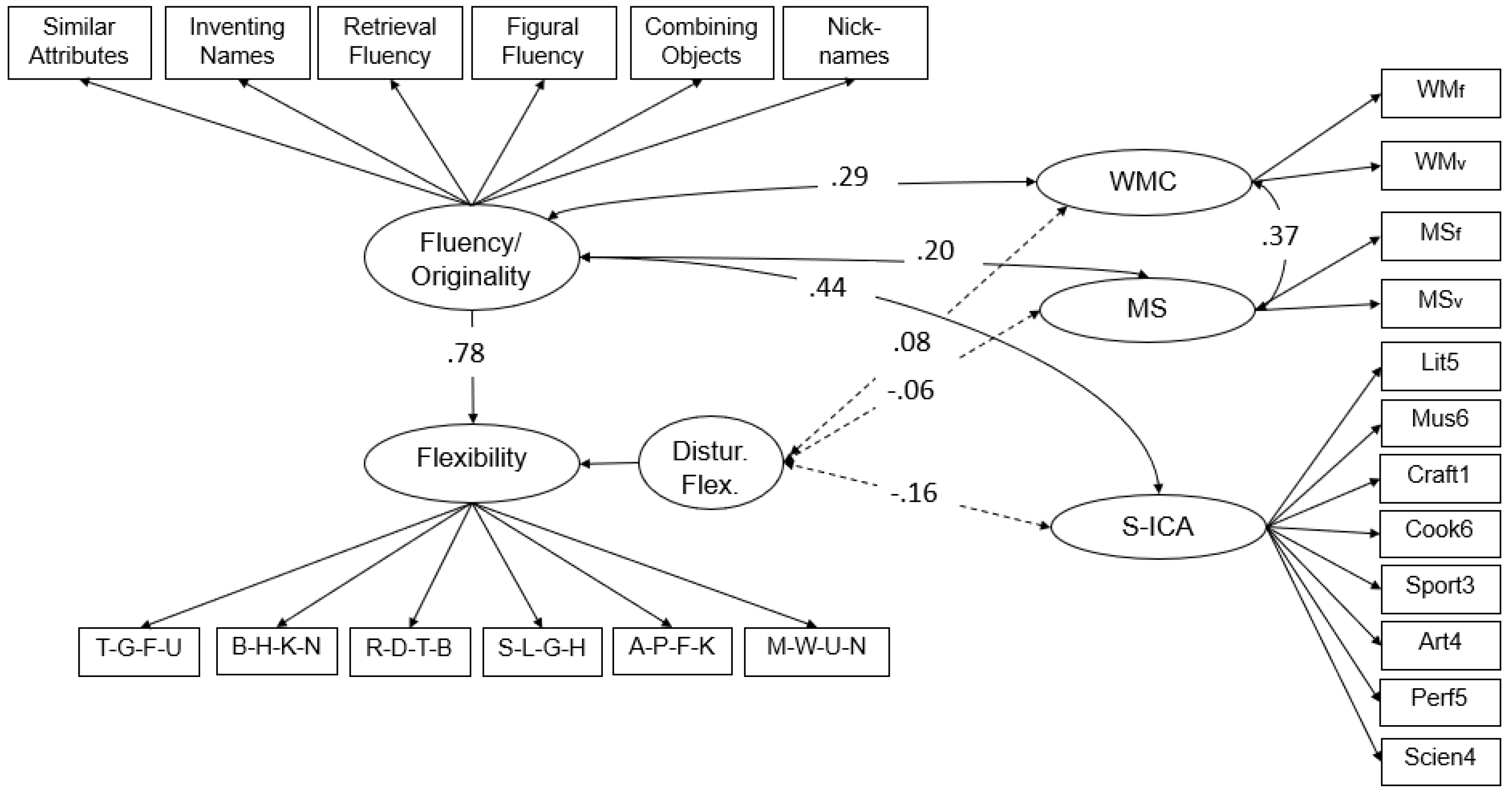Is Flexibility More than Fluency and Originality?
Abstract
1. Introduction
1.1. Understanding Flexibility
1.2. The Present Study
2. Method
2.1. Design and Participants
2.2. Measures
2.2.1. Fluency and Originality
2.2.2. Creative Flexibility
2.2.3. Working Memory Capacity
2.2.4. Mental Speed
2.2.5. Inventory of Creative Activities and Achievement
2.3. Statistical Analyses
Measurement Models
3. Results
4. Discussion
4.1. Flexibility—A Method Factor
4.2. Future Directions of Research
4.3. Conclusions and Outlook
Author Contributions
Funding
Institutional Review Board Statement
Informed Consent Statement
Data Availability Statement
Acknowledgments
Conflicts of Interest
References
- Batey, Mark, and Adrian Furnham. 2006. Creativity, Intelligence, and Personality: A Critical Review of the Scattered Literature. Genetic, Social, and General Psychology Monographs 132: 355–429. [Google Scholar] [CrossRef] [PubMed]
- Benedek, Mathias, Fabiola Franz, Moritz Heene, and Aljoscha C. Neubauer. 2012a. Differential effects of cognitive inhibition and intelligence on creativity. Personality and Individual Differences 53: 480–85. [Google Scholar] [CrossRef] [PubMed]
- Benedek, Mathias, Tanja Könen, and Aljoscha C. Neubauer. 2012b. Associative abilities underlying creativity. Psychology of Aesthetics, Creativity, and the Arts 6: 273–81. [Google Scholar] [CrossRef]
- Boccaletti, Stefano, Vito Latora, Yamir Moreno, Martin Chavez, and D-U. Hwang. 2006. Complex networks: Structure and dynamics. Physics Reports 424: 175–308. [Google Scholar] [CrossRef]
- Brunner, Martin, Gabriel Nagy, and Oliver Wilhelm. 2012. A Tutorial on Hierarchically Structured Constructs: Hierarchically Structured Constructs. Journal of Personality 80: 796–846. [Google Scholar] [CrossRef]
- Carroll, John B. 1993. Human Cognitive Abilities: A Survey of Factor-Analytic Studies. Cambridge: Cambridge University Press. [Google Scholar]
- Colzato, Lorenza S., Mariëtte Huizinga, and Bernhard Hommel. 2009. Recreational cocaine polydrug use impairs cognitive flexibility but not working memory. Psychopharmacology 207: 225–34. [Google Scholar] [CrossRef]
- Cosgrove, Abigail L., Yoed N. Kenett, Roger E. Beaty, and Michele T. Diaz. 2021. Quantifying flexibility in thought: The resiliency of semantic networks differs across the lifespan. Cognition 211: 104631. [Google Scholar] [CrossRef]
- Deák, Gedeon O. 2004. The Development of Cognitive Flexibility and Language Abilities. In Advances in Child Development and Behavior. Amsterdam: Elsevier, Bd. 31, S. 271–327. [Google Scholar] [CrossRef]
- Diedrich, Jennifer, Emanuel Jauk, Paul J. Silvia, Jeffrey M. Gredlein, Aljoscha C. Neubauer, and Mathias Benedek. 2018. Assessment of real-life creativity: The Inventory of Creative Activities and Achievements (ICAA). Psychology of Aesthetics, Creativity, and the Arts 12: 304–16. [Google Scholar] [CrossRef]
- Eid, Michael, Christian Geiser, Tobias Koch, and Moritz Heene. 2017. Anomalous results in G-factor models: Explanations and alternatives. Psychological Methods 22: 541–62. [Google Scholar] [CrossRef]
- Ekstrom, Ruth B., J. W. French, Harry Horace Harman, and D. Derman. 1976. Manual for Kit of Factor-Referenced Cognitive Tests. Princeton: Educational Testing Service. [Google Scholar]
- Feist, Gregory J. 1998. A meta-analysis of personality in scientific and artistic creativity. Personality and Social Psychology Review 2: 290–309. [Google Scholar] [CrossRef]
- Forthmann, Boris, and Philipp Doebler. 2022. Fifty years later and still working: Rediscovering Paulus et al.’s (1970) automated scoring of divergent thinking tests. Psychology of Aesthetics, Creativity, and the Arts. [Google Scholar] [CrossRef]
- Forthmann, Boris, Carsten Szardenings, and Heinz Holling. 2020. Understanding the confounding effect of fluency in divergent thinking scores: Revisiting average scores to quantify artifactual correlation. Psychology of Aesthetics, Creativity, and the Arts 54: 123–33. [Google Scholar] [CrossRef]
- Forthmann, Boris, Corinna Lips, Carsten Szardenings, Jana Scharfen, and Heinz Holling. 2018. Are Speedy Brains Needed when Divergent Thinking is Speeded-or Unspeeded? The Journal of Creative Behavior 54: 123–33. [Google Scholar] [CrossRef]
- Forthmann, Boris, David Jendryczko, Jana Scharfen, Ruben Kleinkorres, Mathias Benedek, and Heinz Holling. 2019. Creative ideation, broad retrieval ability, and processing speed: A confirmatory study of nested cognitive abilities. Intelligence 75: 59–72. [Google Scholar] [CrossRef]
- French, John W., Ruth B. Ekstrom, and Leighton A. Price. 1963. Manual for Kit of Reference Tests for Cognitive Factors (Revised 1963). Princeton: Education Testing Service. [Google Scholar]
- Goecke, Benjamin, Florian Schmitz, and Oliver Wilhelm. 2021. Binding Costs in Processing Efficiency as Determinants of Cognitive Ability. Journal of Intelligence 9: 18. [Google Scholar] [CrossRef]
- Goecke, Benjamin, Selina Weiss, Diana Steger, Ulrich Schroeders, and Oliver Wilhelm. 2020. Testing competing claims about overclaiming. Intelligence 81: 101470. [Google Scholar] [CrossRef]
- Grice, H. Paul. 1975. Logic and Conservation. In Speech Acts. New York: Academic Press, pp. 41–58. [Google Scholar]
- Guilford, Joy Paul. 1956. The Structure of Intellect. Psychological Bulletin 53: 267–93. [Google Scholar] [CrossRef] [PubMed]
- Guilford, Joy Paul. 1967. The Nature of Human Intelligence. New York: McGraw-Hill. [Google Scholar]
- Hargreaves, D. J., and N. Bolton. 1972. Selecting Creativity Tests for Use in Research. British Journal of Psychology 63: 451–62. [Google Scholar] [CrossRef]
- Hartshorne, Joshua K., and Laura T. Germine. 2015. When Does Cognitive Functioning Peak? The Asynchronous Rise and Fall of Different Cognitive Abilities Across the Life Span. Psychological Science 26: 433–43. [Google Scholar] [CrossRef]
- Hildebrandt, Andrea, Oliver Lüdtke, Alexander Robitzsch, Christopher Sommer, and Oliver Wilhelm. 2016. Exploring Factor Model Parameters across Continuous Variables with Local Structural Equation Models. Multivariate Behavioral Research 51: 257–58. [Google Scholar] [CrossRef]
- Hornberg, Jason, and Roni Reiter-Palmon. 2017. Creativity and the big five personality traits: Is the relationship dependent on the creativity measure? In The Cambridge Handbook of Creativity and Personality Research. Edited by Gregory J. Feist, Roni Reiter-Palmon and James C. Kaufman. Cambridge: Cambridge University Press, S. 275–93. [Google Scholar]
- Hu, Li-tze, and Peter M. Bentler. 1999. Cutoff criteria for fit indexes in covariance structure analysis: Conventional criteria versus new alternatives. Structural Equation Modeling: A Multidisciplinary Journal 6: 1–55. [Google Scholar] [CrossRef]
- Ionescu, Thea. 2012. Exploring the nature of cognitive flexibility. New Ideas in Psychology 30: 190–200. [Google Scholar] [CrossRef]
- Jauk, Emanuel, Mathias Benedek, and Aljoscha C. Neubauer. 2014. The Road to Creative Achievement: A Latent Variable Model of Ability and Personality Predictors: The road to creative achievement. European Journal of Personality 28: 95–105. [Google Scholar] [CrossRef] [PubMed]
- Jäger, Adolf Otto. 2006. Berliner Intelligenzstruktur-Test für Jugendliche Begabungs-und Hochbegabungsdiagnostik: BIS-HB. Göttingen: Hogrefe. [Google Scholar]
- Jäger, Adolf Otto, Heinz-Martin Süß, and André Beauducel. 1997. Berliner Intelligenzstruktur-Test: BIS-Test. Göttingen: Hogrefe. [Google Scholar]
- Johnson-Laird, P. N. 1988. Freedom and constraint in creativity. In The Nature of Creativity. Edited by Robert J. Sternberg. Cambridge: Cambridge University Press, S. 202–19. [Google Scholar]
- Kaur, Yadwinder, Guang Ouyang, Werner Sommer, Selina Weiss, Changsong Zhou, and Andrea Hildebrandt. 2020. What Does Temporal Brain Signal Complexity Reveal About Verbal Creativity? Frontiers in Behavioral Neuroscience 14: 146. [Google Scholar] [CrossRef] [PubMed]
- Kaur, Yadwinder, Selina Weiss, Changsong Zhou, Rico Fischer, and Andrea Hildebrandt. 2021. Exploring Neural Signal Complexity as a Potential Link between Creative Thinking, Intelligence, and Cognitive Control. Journal of Intelligence 9: 59. [Google Scholar] [CrossRef]
- Kenett, Yoed N., Roger E. Beaty, Paul J. Silvia, David Anaki, and Miriam Faust. 2016. Structure and flexibility: Investigating the relation between the structure of the mental lexicon, fluid intelligence, and creative achievement. Psychology of Aesthetics, Creativity, and the Arts 10: 377–88. [Google Scholar] [CrossRef]
- Li, Yangping, Yoed N. Kenett, Weiping Hu, and Roger E. Beaty. 2021. Flexible Semantic Network Structure Supports the Production of Creative Metaphor. Creativity Research Journal 33: 209–23. [Google Scholar] [CrossRef]
- McDonald, Roderick P. 1999. Test Theory: A Unified Treatment. Mahwah: L. Erlbaum Associates. [Google Scholar]
- McGrew, Kevin S. 2009. CHC theory and the human cognitive abilities project: Standing on the shoulders of the giants of psychometric intelligence research. Intelligence 37: 1–10. [Google Scholar] [CrossRef]
- Meade, Adam W., and S. Bartholomew Craig. 2012. Identifying careless responses in survey data. Psychological Methods 17: 437–55. [Google Scholar] [CrossRef]
- Monsell, Stephen. 2003. Task switching. Trends in Cognitive Sciences 7: 134–40. [Google Scholar] [CrossRef]
- Nijstad, Bernard A., Carsten KW De Dreu, Eric F. Rietzschel, and Matthijs Baas. 2010. The dual pathway to creativity model: Creative ideation as a function of flexibility and persistence. European Review of Social Psychology 21: 34–77. [Google Scholar] [CrossRef]
- Nusbaum, Emily, and Paul J. Silvia. 2011. Are intelligence and creativity really so different? Fluid intelligence, executive processes, and strategy use in divergent thinking. Intelligence 39: 36–45. [Google Scholar] [CrossRef]
- Preckel, Franzis, Christina Wermer, and Frank M. Spinath. 2011. The interrelationship between speeded and unspeeded divergent thinking and reasoning, and the role of mental speed. Intelligence 39: 378–88. [Google Scholar] [CrossRef]
- Rafner, Janet, Arthur Hjorth, Sebastian Risi, Lotte Philipsen, Charles Dumas, Michael Mose Biskjær, Lior Noy, Kristian Tylén, Carsten Bergenholtz, Jesse Lynch, and et al. 2020. crea.blender: A Neural Network-Based Image Generation Game to Assess Creativity. Paper presented at the 2020 Annual Symposium on Computer-Human Interaction in Play, Virtual, November 2–4; Extended Abstracts. pp. 340–44. [Google Scholar] [CrossRef]
- Raykov, Tenko, and George A. Marcoulides. 2011. Introduction to Psychometric Theory. London: Routledge. [Google Scholar]
- Reiter-Palmon, Roni, Boris Forthmann, and Baptiste Barbot. 2019. Scoring divergent thinking tests: A review and systematic framework. Psychology of Aesthetics, Creativity, and the Arts 13: 144–52. [Google Scholar] [CrossRef]
- Revelle, William. 2018. psych: Procedures for Psychological, Psychometric, and Personality Research. R package Version 1. Evanston: Northwestern University. [Google Scholar]
- Rosen, Virginia M., and Randall W. Engle. 1997. The Role of Working Memory Capacity in Retrieval. Jorunal of Experimental Psychology: General 126: 211–27. [Google Scholar] [CrossRef]
- Rosseel, Yves. 2012. Lavaan: An R package for structural equation modeling and more. Version 0.5–12 (BETA). Journal of Statistical Software 48: 1–36. [Google Scholar] [CrossRef]
- Runco, Mark A. 1986. Flexibility and Originality in Children’s Divergent Thinking. The Journal of Psychology 120: 345–52. [Google Scholar] [CrossRef]
- Runco, Mark A., and Shawn M. Okuda. 1991. The instructional enhancement of the flexibility and originality scores of divergent thinking tests. Applied Cognitive Psychology 5: 435–41. [Google Scholar] [CrossRef]
- Schafer, Joseph L., and John W. Graham. 2002. Missing data: Our view of the state of the art. Psychological Methods 7: 147–77. [Google Scholar] [CrossRef]
- Schmitz, Florian, and Oliver Wilhelm. 2016. Modeling Mental Speed: Decomposing Response Time Distributions in Elementary Cognitive Tasks and Correlations with Working Memory Capacity and Fluid Intelligence. Journal of Intelligence 4: 13. [Google Scholar] [CrossRef]
- Schmitz, Florian, Dominik Rotter, and Oliver Wilhelm. 2018. Scoring Alternatives for Mental Speed Tests: Measurement Issues and Validity for Working Memory Capacity and the Attentional Blink Effect. Journal of Intelligence 6: 47. [Google Scholar] [CrossRef]
- Schoppe, Karl-Josef. 1975. Verbaler Kreativitäts-Test-VKT: Ein Verfahren zur Erfassung verbal-produktiver Kreativitätsmerkmale. Göttingen: Verlag für Psychologie CJ Hogrefe. [Google Scholar]
- Shen, Wangbing, Bernhard Hommel, Yuan Yuan, Liu Chang, and Wei Zhang. 2018. Risk-Taking and Creativity: Convergent, but Not Divergent Thinking Is Better in Low-Risk Takers. Creativity Research Journal 30: 224–31. [Google Scholar] [CrossRef]
- Sheppard, Leah D., and Philip A. Vernon. 2008. Intelligence and speed of information-processing: A review of 50 years of research. Personality and Individual Differences 44: 535–51. [Google Scholar] [CrossRef]
- Shrout, Patrick E., and Joseph L. Fleiss. 1979. Intraclass Correlations: Uses in Assessing Rater Reliability. Psychological Bulletin 86: 420–28. [Google Scholar] [CrossRef]
- Silvia, Paul J. 2008. Creativity and Intelligence Revisited: A Latent Variable Analysis of Wallach and Kogan. Creativity Research Journal 20: 34–39. [Google Scholar] [CrossRef]
- Silvia, Paul J., Christopher Martin, and Emily C. Nusbaum. 2009. A snapshot of creativity: Evaluating a quick and simple method for assessing divergent thinking. Thinking Skills and Creativity 4: 79–85. [Google Scholar] [CrossRef]
- Silvia, Paul J., Roger E. Beaty, and Emily C. Nusbaum. 2013. Verbal fluency and creativity: General and specific contributions of broad retrieval ability (Gr) factors to divergent thinking. Intelligence 41: 328–40. [Google Scholar] [CrossRef]
- Steger, D., S. Weiss, and O. Wilhelm. 2022. The short inventory of creative activities (S-ICA): Compiling a short scale using ant colony optimization. Creativity Research Journal. [Google Scholar] [CrossRef]
- Unsworth, Nash, Gene A. Brewer, and Gregory J. Spillers. 2013. Working memory capacity and retrieval from long-term memory: The role of controlled search. Memory and Cognition 41: 242–54. [Google Scholar] [CrossRef]
- Weiss, Selina, Diana Steger, Ulrich Schroeders, and Oliver Wilhelm. 2020. A reappraisal of the threshold hypothesis of creativity and intelligence. Journal of Intelligence 8: 38. [Google Scholar] [CrossRef]
- Weiss, Selina, Diana Steger, Yadwinder Kaur, Andrea Hildebrandt, Ulrich Schroeders, and Oliver Wilhelm. 2021a. On the Trail of Creativity: Dimensionality of Divergent Thinking and Its Relation With Cognitive Abilities, Personality, and Insight. European Journal of Personality 35: 291–314. [Google Scholar] [CrossRef]
- Weiss, Selina, Oliver Wilhelm, and Patrick Kyllonen. 2021b. An improved taxonomy of creativity measures based on salient task attributes. Psychology of Aesthetics, Creativity, and the Arts. [Google Scholar] [CrossRef]
- Wilhelm, Oliver, Andrea Hildebrandt, and Klaus Oberauer. 2013. What is working memory capacity, and how can we measure it? Frontiers in Psychology 4: 433. [Google Scholar] [CrossRef]
- Wilson, Robert C., J. P. Guilford, Paul R. Christensen, and Donald J. Lewis. 1954. A factor-analytic study of creative-thinking abilities. Psychometrika 19: 297–311. [Google Scholar] [CrossRef]
- Zhang, Weitao, Zsuzsika Sjoerds, and Bernhard Hommel. 2020. Metacontrol of human creativity: The neurocognitive mechanisms of convergent and divergent thinking. NeuroImage 210: 116572. [Google Scholar] [CrossRef]




| Factor | Description |
|---|---|
| Figural Adaptive Flexibility | “The ability to change set in order to meet new requirements imposed by figural problems” (p. 49) |
| Semantic Spontaneous Flexibility | “The ability to produce a diversity of verbally expressed ideas in a situation that is relatively unrestricted” (p. 50) |
| Figural Flexibility | “The ability to change set in order to generate new and different solutions to figural problems” (p. 73) |
| Flexibility of Use | “The mental set necessary to think of different uses for objects” (p. 197) |
| Item | Mean (SD) | Min | Max | ICC |
|---|---|---|---|---|
| #1 (T-G-F-U) | 3.08 (1.69) | 0 | 8 | .99 |
| #2 (B-H-K-N) | 3.72 (1.96) | 0 | 10 | .99 |
| #3 (R-D-T-B) | 2.87 (1.73) | 0 | 9.67 | .99 |
| #4 (S-L-G-H) | 3.47 (1.84) | 0 | 10 | .98 |
| #5 (A-P-F-K) | 2.82 (1.63) | 0 | 8 | .99 |
| #6 (M-W-U-N) | 2.97 (1.73) | 0 | 8.33 | .99 |
Publisher’s Note: MDPI stays neutral with regard to jurisdictional claims in published maps and institutional affiliations. |
© 2022 by the authors. Licensee MDPI, Basel, Switzerland. This article is an open access article distributed under the terms and conditions of the Creative Commons Attribution (CC BY) license (https://creativecommons.org/licenses/by/4.0/).
Share and Cite
Weiss, S.; Wilhelm, O. Is Flexibility More than Fluency and Originality? J. Intell. 2022, 10, 96. https://doi.org/10.3390/jintelligence10040096
Weiss S, Wilhelm O. Is Flexibility More than Fluency and Originality? Journal of Intelligence. 2022; 10(4):96. https://doi.org/10.3390/jintelligence10040096
Chicago/Turabian StyleWeiss, Selina, and Oliver Wilhelm. 2022. "Is Flexibility More than Fluency and Originality?" Journal of Intelligence 10, no. 4: 96. https://doi.org/10.3390/jintelligence10040096
APA StyleWeiss, S., & Wilhelm, O. (2022). Is Flexibility More than Fluency and Originality? Journal of Intelligence, 10(4), 96. https://doi.org/10.3390/jintelligence10040096





